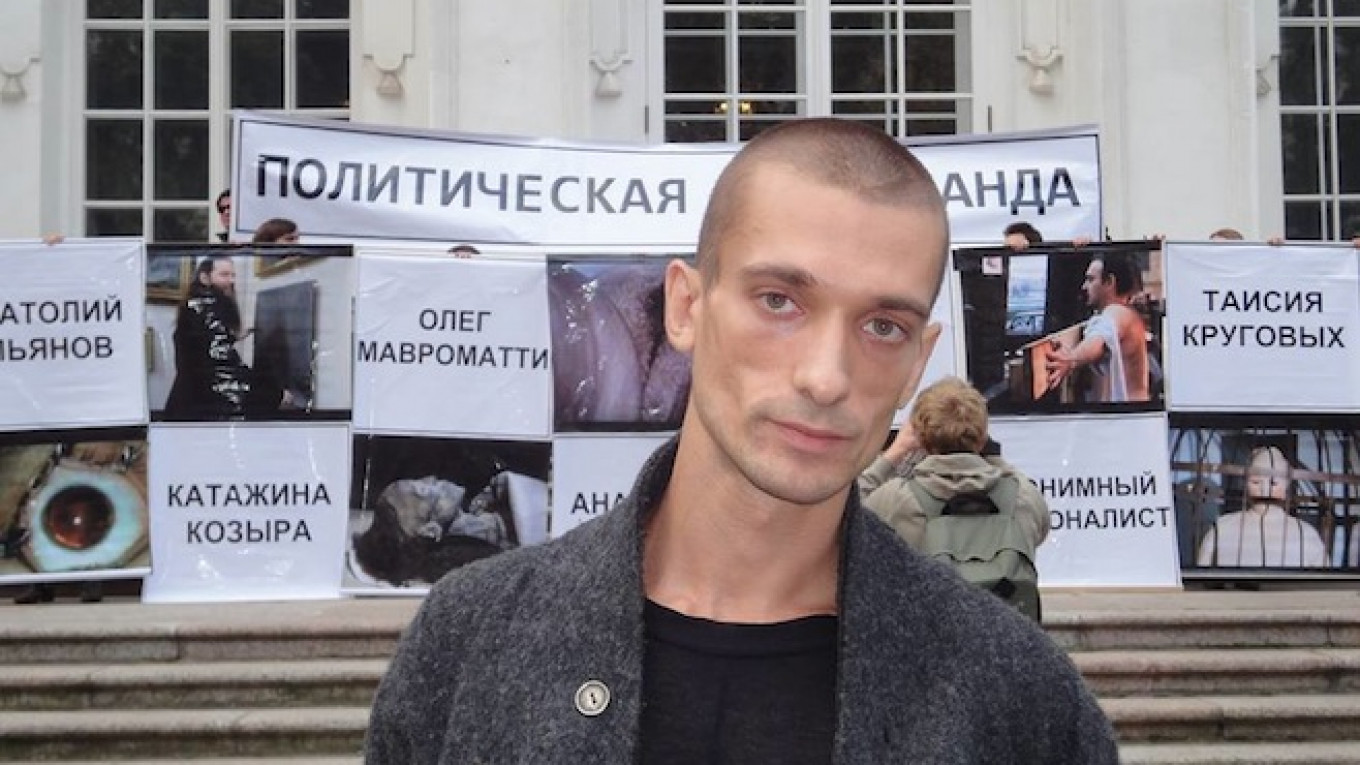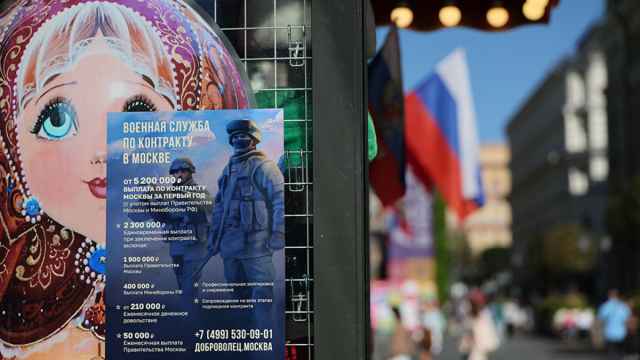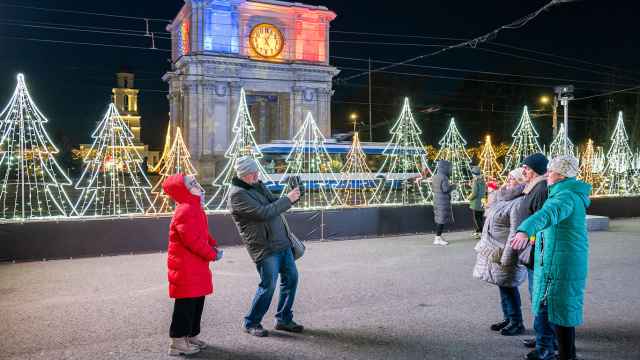When young investigator Pavel Yasman was tasked with interrogating Russian artist Pyotr Pavlensky, known for his shocking political protest stunts, he never imagined that their conversations would change his life.
After several months of interacting with the St. Petersburg artist, Yasman quit his job at Russia’s all-powerful Investigative Committee and crossed over to the other side — and after receiving a lawyer’s license, was even prepared to represent the artist in a court hearing into the same case earlier this month.
“Pavlensky is a very strong person. I think it’s great to believe so fervently in what you are doing,” Yasman told The Moscow Times in a phone interview Thursday.
Pavlensky is charged with vandalizing a historic bridge in central St. Petersburg in February 2014, when together with some friends, he burned stacks of tires in an imitation of protesters’ barricades blazing in the Ukrainian capital Kiev at that time.
The St. Petersburg court that is currently hearing the case rejected Pavlensky’s request to allow his erstwhile opponent to represent him, ruling that as a former investigator in the case, Yasman is an interested party. If found guilty, Pavlensky faces up to three years in prison. He is currently under oath not to leave the area.
During three interrogation sessions from March to June last year that are better described as conversations, Yasman, 30, and Pavlensky, 31, mostly discussed the limits of what is permissible in art. According to transcripts of their conversations released by Pavlensky and confirmed as authentic — and even “cool” — by Yasman, the investigator insisted that burning tires in support of Ukraine’s protest movement may be art, but it is also the vandalism of St. Petersburg’s UNESCO-protected city center.
“I admire Andrei Rublev’s ‘Trinity’ [a revered 15th-century icon] and want a little part of me to remain on it — so I piss on it,” Yasman says in the first interrogation, comparing this scenario to Pavlensky’s actions. The transcripts were initially published by Snob magazine on its website.
Pavlensky argued that burning tires on the bridge was a physical metaphor for the events in Ukraine, and insisted the bridge was not damaged by the performance.
At the beginning of their conversation, Yasman’s attitude is sardonic. He suggests anyone can do the kind of art that Pavlensky creates. “I am an artist of justice!” the investigator declares at one point. “The context of my art is statistics. First of all, with my artistic work I have achieved social justice, secondly, I have made an invaluable contribution to the formation of statistical reports,” he says.
But over time, Yasman’s attitude can be seen in the transcripts to be evolving. Pavlensky’s articulate, straightforward answers belie numerous attempts by investigators to have the artist incarcerated in a psychiatric institution. Gradually, Yasman begins to reveal that he is being pushed to pursue the case by his superiors.
“Pyotr Andreyevich, I already got thoroughly screwed [by my superiors] because your case is still not in court,” Yasman tells Pavlensky in one of the final interrogation sessions.
“So you agree that you are just a tool. The government simply makes tools out of people,” Pavlensky responds in the transcripts, to which Yasman says: “I agree.”
Changing Sides
That was the end of Yasman’s career in Russia’s law enforcement structures. Shortly after, he submitted his resignation and began to prepare for exams to become a qualified lawyer.
“I think his [Pavlensky’s] work has made many people become more critical and change their worldview,” Yasman told The Moscow Times.
He said his conversations with Pavlensky had triggered his decision to leave the Investigative Committee, but also said he had thought about doing so previously.
Pavlensky said during a phone interview with The Moscow Times that he never expected Yasman to come over to his side.
“I thought he was just trying to put me at ease and make me trust him during the interrogations,” the artist said Friday.
At the same time, he said, he realized that law enforcement officers can hold beliefs that are far from the government line.
“People in law enforcement agencies are forced to become tools; everything human in them is suppressed,” Pavlensky said.
“But many of them doubt that what they are doing is right, so the human element can rebel against the functional one,” he said.
Artistic Scandals
During the past three years, Pavlensky has become one of the most talked-about figures on the Russian art scene for his scandalous political performances.
In one of the first in 2012, Pavlensky stood on St. Petersburg’s main street, Nevsky Prospekt, in front of the austere Kazan cathedral, his lips sewn together with a coarse thread, in protest at the trial of feminist protest art group Pussy Riot that was under way at the time.
Nine months later, Pavlensky wrapped a length of barbed wire around his naked body and lay on the ground in front of the St. Petersburg parliament until police arrived at the scene with wire cutters.
In his best-known feat in November 2013, Pavlensky hammered a nail through his scrotum to the cobblestones of Moscow’s Red Square and sat naked in front of the Lenin Mausoleum in what he said was an attempt to highlight the apathy and indifference of Russian society.
Protesting against the continuation in modern Russia of the Soviet tradition of using psychiatry to crush political dissent, last October Pavlensky cut his earlobe with a chef’s knife while perched on the roof of Moscow’s most infamous psychiatric facility, the Serbsky Institute.
Tip of the Iceberg
According to Pavlensky’s lawyer Dmitry Dinze, what happened with Yasman reveals a broader trend in Russia’s law enforcement system.
“The system is completely corrupt at present and many people do not want to be a part of it,” said Dinze, who is himself a former investigator. He quit his job after being pressured by his superiors to accuse an innocent man of murder, he said.
“At the same time, many young people dream of becoming an investigator. There are many perks,” said Dinze, who was also present at Pavlensky’s interrogations with Yasman.
Pavlensky said he suspected a similar clash of ideals had taken place within Irina Klementyeva, the investigator assigned to replace Yasman after he quit.
Klementyeva was pushing hard for Pavlensky to be subjected to a spell in a psychiatric ward, but after the artist cut his earlobe on the roof of the Serbsky Institute, the investigator disappeared from the case, according to Pavlensky.
A group of seven investigators was subsequently put on his case.
According to Dinze, Pavlensky’s case is being actively pushed forward by senior members of the St. Petersburg branches of the Prosecutor General’s Office and Investigative Committee.
The former investigator said he believes the reason his client’s case has attracted so much attention from the authorities might be that his art is apparently able to change people’s minds.
“Many people write me letters of support saying that their worldview has been transformed because of my work,” said Pavlensky.
“Often they apologize for thinking at first that I was crazy and that what I do is nonsense,” he said.
Pavlensky added that he is responsible for just a fraction of his work in changing the way people think. The rest, he said, is done by government officials and the media via their reactions to his art.
Contact the author at [email protected]
A Message from The Moscow Times:
Dear readers,
We are facing unprecedented challenges. Russia's Prosecutor General's Office has designated The Moscow Times as an "undesirable" organization, criminalizing our work and putting our staff at risk of prosecution. This follows our earlier unjust labeling as a "foreign agent."
These actions are direct attempts to silence independent journalism in Russia. The authorities claim our work "discredits the decisions of the Russian leadership." We see things differently: we strive to provide accurate, unbiased reporting on Russia.
We, the journalists of The Moscow Times, refuse to be silenced. But to continue our work, we need your help.
Your support, no matter how small, makes a world of difference. If you can, please support us monthly starting from just $2. It's quick to set up, and every contribution makes a significant impact.
By supporting The Moscow Times, you're defending open, independent journalism in the face of repression. Thank you for standing with us.
Remind me later.






